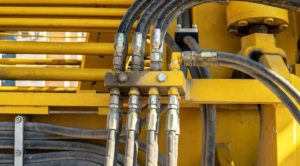
The adverse effects of replacing a hydraulic hose with the incorrect size.
At a Glance:
- Replacing worn-out couplings with the incorrect size can cause unintended consequences.
- Flow velocity is an important consideration when replacing a larger hydraulic hose inside diameter with a smaller hydraulic hose inside diameter.
- Learn how to calculate flow velocity.
Suppliers of hydraulic hose assemblies will face this common scenario: An end-user brings in a worn-out hydraulic hose to be replaced, but the couplings needed for this particular size hose are out of stock, backordered or the store doesn’t stock the couplings needed to replicate the original hose assembly. However, you do stock the correct couplings in a smaller hose size inside diameter (ID).
The logical solution might be to rebuild the hose assembly using the smaller size hydraulic hose with a jump-size fitting. Though this may seem like a harmless solution, replacing a hose assembly with a smaller hose size than what was designed for that hydraulic system could cause unintended harm and create inefficiency to the equipment.
What is affected when you replace a hose with the incorrect hose size?
Flow is the movement of fluid and is broken down into two categories: flow rate and flow velocity. Flow rate is the volume of hydraulic fluid produced by the hydraulic pump over a specific amount of time and is commonly measured using gallons per minute or GPM. Flow velocity is the speed at which hydraulic fluid travels in a certain direction over a specific amount of time and is measured using feet per second.
Flow velocity is determined by both the hydraulic pump’s flow rate and the hydraulic hose size. Changing the flow rate of the hydraulic pump but leaving the hydraulic hose size the same will affect flow velocity. In contrast, keeping the flow rate the same but changing the hose size will affect flow velocity.
Flow velocity is an important consideration when replacing a larger hydraulic hose ID with a smaller hydraulic hose ID. When an existing hydraulic hose is replaced with a new hydraulic hose that has a smaller ID, the same amount of fluid that was flowing through the original, larger hydraulic hose is now forced through the new, smaller hose. This will restrict flow and increase downstream pressure, thus causing flow velocity to increase.
In some situations, this might not be a problem, so it is important to properly analyze the situation. An easy option to avoid this problem is to size-up to the next larger hose size. However, larger hoses usually come with a higher price, plus larger hoses take up space and could even decrease the customer’s equipment performance.
Why can high flow velocity be undesirable for a hydraulic system?
Flow velocity determines if the flow pattern will be in a laminar or turbulent state. Ideally, we would like for flow to be a steady, smooth and uniform pattern from the pump all the way to the actuator. This pattern is referred to as laminar flow. Laminar flow is achieved at lower velocities, and the fluid layers move in a nice, even, parallel flow pattern.
This flow pattern is ideal to minimize friction and pressure drops and maximizes hydraulic system efficiency. Fluid-on-fluid friction will still be created as the layers of fluid, which are flowing at different velocity rates, slide on each other, but this is expected. A laminar flow pattern also provides better system response, lubrication and decreases air pockets or bubbles that can cause inefficiencies.
The higher the flow velocity, the more turbulent flow characteristic are seen. When flow velocity is high, the roughness on the surface of the inner tube will disrupt the flow path and cause it to become chaotic. Turbulent flow patterns cause a decrease in energy in the form of friction (law of conservation of energy), resulting in unwanted pressure drops and hydraulic system inefficiencies.
Furthermore, high flow velocity also causes increased fluid temperatures. Fluid temperature has been empirically linked to significant reduction in hose life, so a reduction in hose size may also cause unwanted system downtime.
For more information about our services or to ask any questions, please don’t hesitate to give the team a call on +97165566172 or e-mail them on info@alfeeltrading.com

